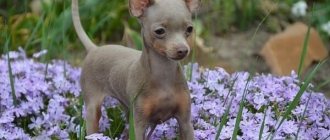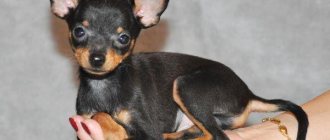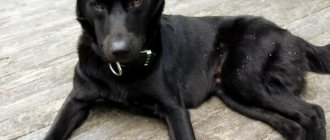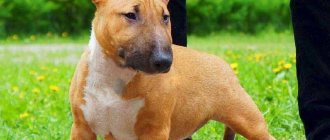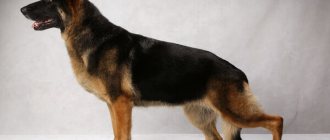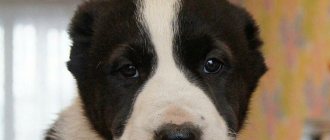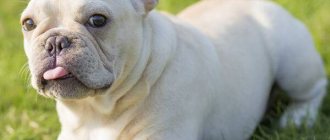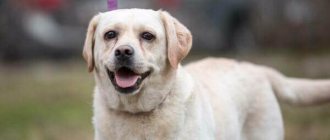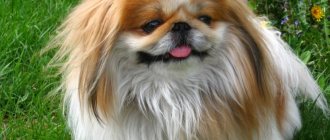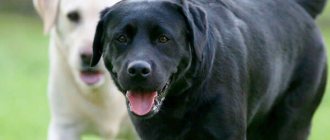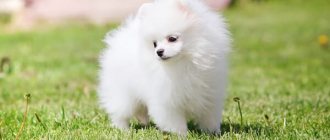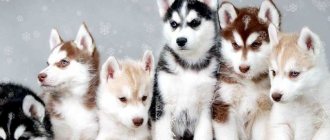Alabai (Central Asian Shepherd Dog) is a large dog, distinguished by powerful bones, strength and calmness, an excellent watchman and guard.
Characteristic features are love of freedom, pride and excellent fighting qualities.
Such a dog will never fulfill the whims of its owner; it can only be a friend or an enemy.
Therefore, maintaining it requires a strong character and considerable experience in dog breeding.
Origin story and what it looks like in the photo
The history of the Black Alabais dates back to about 4,000 years ago . In the territory from the Caspian Sea to the Southern Urals and China, these dogs were faithful companions of shepherds.
The black alabai is closely related to the Tibetan mastiff and the Mongolian shepherd dog. It is believed that it was from them that the breed took the genes responsible for its black color.
The appearance, strength and power of the dog were formed thanks to the harsh conditions in which the animals lived . The fight against predators, a difficult climate, and a minimum of water and food made the dog fearless and unpretentious.
It is worth saying that only the strongest and healthiest individuals survived in such conditions. It was they who passed on their genes to their offspring, while the weaker ones died.
If we talk about factory work, it began to be carried out in the USSR only in the 30s of the 20th century . But the breed acquired official status only in the 80s. Now black Alabais are used as watchmen, security guards and service dogs.
Why are ears cropped?
Cropping of an animal's ears is done for the following reasons:
- Aesthetic purpose.
- Therapeutic purpose.
In ancient times, the ears and tails of pets were constantly trimmed. This was due to their purpose. The fact is that they could interfere in fights with predators and other dogs.
Nowadays, each breeder and owner chooses what to do. Some people think that Alabai does not look like himself with big ears and a tail. Others are of the opinion that docking is an outdated method that only causes pain to the animal.
Marriage or breed?
The black color of alabai should in no way be considered a defect or a defect. The only exception is a pronounced saddle cloth (color, like a German shepherd).
The Alabais consider marriage based on color:
- Any shade of chocolate and all its combinations, with a brown nose, lips and eyelid edges.
- A blue tint in different variations, with a gray nose, eyelids and lips.
Expert opinion
Kozhevin Semyon Kirillovich
Expert dog handler.
“The distinctive features of black Alabais can be called: large size, height above average, strong physique and rough constitution. The dog is distinguished by its viciousness, mistrust and willfulness. She is wary of strangers and neutral of children. The dog has strong muscles, thick skin and a somewhat loose build.”
Character traits
As a rule, Alabai have a calmly balanced type of psyche, which is characterized by:
- Mobility.
- Force.
- Sustainability.
- Slowness.
- Equilibrium
- Calm.
- No fussiness.
- Slow response to stimuli.
These dogs are reliable, unpretentious and independent..
It is worth saying that bitches are more dynamic and emotional, at the same time they are more flexible and amenable to training.
CAREFULLY!
Alabai are wary of strangers, and they react aggressively to intrusions into their territory.
A characteristic feature of the breed is pronounced dimorphism . As a rule, male dogs, when protecting the territory, silently rushes at the trespasser.
Bitches are usually more cautious; they prefer to bark at the intruder and block his path. A bitch will attack only as a last resort.
Alabais are distinguished by very high intelligence; they not only understand, but also feel the owner . At the same time, dogs are quite touchy and vindictive; you should not scold or punish them for no reason.
Raising puppies
In order for the Central Asian Shepherd Alabai to grow up docile and manageable, you need to take a small puppy for training. The owner should spend a decent amount of time playing with the pet, because this way he not only has fun, but also learns the main lesson in life: who plays what roles, who dominates and who submits.
Like all small children, puppies are not very obedient and will refuse to do anything they don't want to do. The goal of a person is to stimulate learning through arousing interest.
Right actions should be rewarded. For this purpose, some kind of treat is suitable, which is not part of the daily diet. But it’s also a good idea to educate with treats, so you can actively use affection, for example, stroking the scruff of the neck. Kind words should a priori be familiar to the tailed one.
Contrary to popular belief, physical punishment can make a puppy angry. Perhaps at first the hidden anger will not appear, but one day there is a risk of becoming a victim of the dog’s aggression for past “merits”.
Advantages and disadvantages
The advantages of the breed include:
- High intelligence and excellent security qualities.
- Devotion to the owner.
- Wool that has self-cleaning properties.
- Unpretentiousness in food and moderate appetite.
- Unpretentiousness to living conditions. A pet can easily withstand cold, heat, and sudden temperature changes.
- Calmness and restraint of character.
- No tendency to bark for no reason.
- Loyal attitude towards children.
Disadvantages of the breed:
- The dog is not adapted to living in an apartment due to its large size.
- Requires long walks and serious physical activity.
- Suitable only for strong-willed and strong people.
- Has a tendency to dominate.
- When training, the services of a professional dog handler are required.
- Aggression towards other dogs.
- Tendency to wander and pick up scraps.
- Low socialization.
Dimensions, weight and other distinctive features
Pet size and weight:
Male:
- Height – from 70 – 80 cm.
- Weight – from 70 to 80 kg.
Bitch:
- Height – from 65 to 72 cm.
- Weight – from 50 to 70 kg.
A distinctive feature of black Alabais lies in their specific genes . So from one litter from black parents completely different puppies can appear.
Moreover, they will differ in color (not all of them are black), in character, temperament, and attitude towards people.
The path to perfection
In order for the Alabai to be able to accomplish everything planned by man, endurance, courage and strength must already be programmed into the genetics of the animal. In addition, we cannot talk about pet aggression towards humans, since animals were often left with children.
The culling of frail, cowardly and aggressive puppies was carried out very carefully. In each new generation, the Alabai acquired stronger features, became fearless, combat-ready, and prudent in their own endurance. Having come such a long way since the time of taming the mastiff, the Alabai turned out to be an ideal dog for living with a person, becoming his reliable companion and protector. This breed combines the best features of herding dogs, Tibetan black wolves and fighting dogs.
The main character traits of Alabai puppies:
- Openness and sincerity.
- Independence. Even as puppies they are able to survive in the forest alone.
- Loyalty. No matter how much a stranger manages to feed an Alabai, the animal will never betray its owner, even if he is not ideal. By the way, this fact also applies to puppies.
- Fearfulness and mistrust can be transmitted to a puppy from its mother.
Alabai ranks 8th among the largest dogs. By the way, the weight of the record holder of this breed is 125 kilograms, and if he stands by his hind limbs, he will reach 2 m in height. When the puppy was 2 months old, the pet’s body weight was already at 20 kg. The owner of his four-legged friend then realized: the dog would grow up to be unusual. This Central Asian Shepherd actually became world famous, its photographs spread all over the World Wide Web, and the dog became the owner of numerous awards and certificates for its size. At the same time, the Alabai Bulldozer, despite his impressive parameters, loves children, happily giving them rides on his back.
Life expectancy and major diseases
The life expectancy of black alabai is from 12 to 15 years.
Main diseases :
- Obesity. About 30% of pets kept in apartments suffer from this disease. An unhealthy diet and a sedentary lifestyle also contribute to the appearance of excess weight. Another cause of obesity is heart attack.
- Diseases of the cardiovascular system (myocardial infarction, arrhythmia, etc.).
- Joint diseases (hip and elbow dysplasia, arthritis, rickets, myositis, arthrosis). The reason is the large weight of the animal, which puts increased stress on the paws.
- Skin diseases (demodex, ringworm, fungus, fleas and ticks).
- Cryptorchidism (non-descent of the testicle into the scrotum in males). The disease is considered genetic.
- Diabetes.
- Infertility in bitches is also caused by genetic abnormalities.
- Deafness.
- Intestinal obstruction.
- Enterocolitis.
Diseases
It is almost impossible to make any generalizations about the health of this species. Breeders claim that these are some of the healthiest individuals of all large breeds. The health of the Central Asian Shepherd is connected with its history. Dogs lived in some of the harshest conditions on Earth. At the same time, they fought against dangerous predators. Only the strongest could survive, and any genetic defects would be quickly eliminated.
However, those pets that have recently been crossed with other species may be susceptible to genetic diseases of those breeds.
The animal is known to have skeletal and visual problems. Therefore, owners are strongly advised to have new family members checked by veterinarians immediately. They will conduct genetic and other tests to identify potential health defects. This is especially valuable for conditions that appear in old age.
Large Alabai dogs are prone to the following problems:
- Hip dysplasia.
- Elbow dysplasia.
- Skeletal growth disorders.
- Heart failure.
- Heart problems.
- Problems with the spine.
- Arthritis.
- Bloating/Gastric Torsion.
- Progressive retinal atrophy.
- Cataract.
- Glaucoma.
- Heat intolerance.
- Deafness.
- Infections and parasites.
- Obesity.
- Dental problems.
Here is a detailed description of several serious diseases.
Hip dysplasia.
Hip dysplasia is one of the most common serious inherited diseases in domestic dogs. It is caused by a malformation of the above-mentioned joint.
Where the upper leg bone meets the femur, an “acetabulum” is created, shaped like a rounded, concave socket. In a healthy dog, the head of the femur, or kaput, fits almost perfectly into the acetabulum. Both are covered with a protective layer of cartilage. This cartilage prevents the two bones from rubbing directly against each other. The cause of the disease is a problem with the shape of the femur, the shape of the acetabulum, the cartilage between them, or perhaps some combination of these. Symptoms: lameness in the legs, the animal has difficulty standing up. Seek help from a specialist.
Bloating/Gastric Torsion.
Gastric torsion, more commonly known as bloat, is one of the most serious health problems in pet dogs. Without timely medical care, it usually leads to death. The death of a dog can happen in just one day!
In this condition, food and gas cannot leave the stomach. This promotes their accumulation, which increases bloating. As more and more food and bubbles become trapped, the stomach swells and expands.
The main symptoms: a sharp increase in the dog’s tummy, malaise, heavy breathing, vomiting with foam, pallor of the mucous membranes. Contact your veterinarian immediately.
Progressive retinal atrophy.
Progressive retinal atrophy is one of the most common genetically inherited conditions found in domestic dogs. This is the main cause of blindness in your pets.
The retina is located at the very back of the eye. It is responsible for collecting visual images and transmitting them to the brain through the optic nerve. The retina is divided into the inner or neural retina and the outer retina or retinal pigmented epithelium. The inner retina is further divided into nine layers, the outermost of which contains photoreceptor cells. They are usually called sticks.
The rods function in low light and detect shapes and movement. In animals with progressive retinal atrophy, rod cells are gradually destroyed. This happens until the dog becomes completely blind. The disease almost always affects both eyes equally, leaving the dog completely blind at one point. Symptoms: Your pet has decreased vision in low light or at dusk. For treatment, contact your veterinarian.
Glaucoma.
Glaucoma is an imbalance of fluid pressure in the eye. There is a fluid inside the eye called aqueous humor. Its composition is completely different from tears. Water humor is responsible for maintaining the correct shape and pressure inside the eye. It is constantly produced by the body, a process sometimes called "the tap." To maintain proper pressure, fluid must be drained regularly from the eye into the bloodstream. Water humor flows out of the eye through a mesh-like structure known as the drainage angle or "drain".
Glaucoma occurs when there is some problem with the drainage angle that prevents the proper release of aqueous humor. Water humor begins to fill the eye, causing it to expand like a balloon. As a result, intraocular pressure increases sharply.
Glaucoma varies greatly in severity and rate of occurrence. In some dogs, glaucoma worsens over weeks or months. For others, the condition results in permanent blindness over a period of days or even hours. Symptoms: watery eyes, constantly dilated pupil, swollen cornea, you notice that the animal sees worse. Contact your veterinarian for help.
Rules of care
How to properly care for your pet:
- You should bathe your dog 2-3 times a year. The coat of the black Alabai is resistant to dirt and the dog looks neat, even living on the street.
- Brush the dog during shedding, in spring and autumn.
- Despite the fact that the dog is in excellent health, he should be shown to the veterinarian at least once a year.
- The dog must receive all necessary vaccinations annually.
- Once every six months, the dog is given medications to prevent helminthic infestation.
- Alabais need daily walks and physical activity. Moreover, the duration of each walk should be at least 1-2 hours. Walk the dog 2 times a day.
- An adult dog is also fed 2 times a day. The main products he is given are meat, offal, entrails or boiled fish. Also, the dog’s diet should include vegetables, dairy products, cereals and herbs.
- Clean your pet's ears once a week using wet wipes soaked in vegetable oil.
- The dog's nails are cut once every 2 weeks using a special nail clipper.
- Alabai's eyes should be examined daily for signs of discharge. If there is slight discharge, wipe the eyes with a cotton pad soaked in chamomile decoction.
- The pet's teeth are brushed once a week with a special brush and toothpaste intended for dogs.
What do the puppies look like?
Black Alabay puppies have a massive head, pronounced brow ridges, a heavy chin and strong paws.
Babies have a large, black nose, drooping ears, round and very dark eyes . At the same time, the look is expressive, confident and calm. The claws of such a puppy are dark, as are the paw pads and lips.
Black Alabai babies have a very thick “plush” coat and a soft, dense undercoat . On the head and front legs, the hair lies tightly to the skin, and behind the ears, on the tail and hind legs there are lush feathers.
Appearance
The head is massive and wide. The forehead is flat. The nose is large, black or brown. The pet's jaws are powerful. There are 42 white teeth in the mouth.
The ears are triangular in shape and medium in size. Sometimes they are pruned if this is not prohibited in the country.
— Advertising —
Eyes: wide-set, round, dark in color.
The pet's body is powerful. The neck is short and muscular. The chest is large, the ribs are rounded. The loin is short, wide, slightly convex. The abdomen is moderately tucked. The back is strong, straight, wide.
The tail is thick at the base and set high. In a calm state, the tail is ring-shaped. In some individuals it is docked, unless this is prohibited in the country.
The coat is hard, straight and rough. The length depends on the type. Long-haired: 7 to 8 cm in length, short-haired: 3 to 5 cm in length. Under the fur there is a thick undercoat.
Alabai colors include the following: white, black, black and white, gray, straw, reddish brown, red, brindle, motley, spotted.
Pictures of black and white alabai are presented below.
The size of the Alabai dog is impressive.
Height: male 65-78 centimeters, female 60-69 centimeters.
Weight: male 50-79 kilograms, female 40-65 kilograms.
How to choose?
When choosing a puppy you should always focus on several factors:
- Choosing a nursery. The nursery must have a good reputation and have been operating for more than one year.
- Parents of the puppy. It is very advisable to get to know the mother and father of the baby before purchasing, and also to observe them. Dogs must be healthy, well-groomed and fit.
- Impressions from the breeder. A good breeder always gives complete information about the dogs, does not object to examining the puppy and its mother, and will also provide all the necessary information and documents.
- Presence or absence of documents.
- Price.
In addition, before purchasing, you should pay attention to the external characteristics of the puppy . A healthy pet always has clean eyes and ears, pink gums and shiny fur. You should also pay attention to the bite; in Alabais it is scissor-shaped.
The puppy should not smell bad, he should not be itching to bite himself - this is a sign of the presence of fleas or ticks. It is also worth paying attention to the nose and paw pads; they must be dark.
IMPORTANT!
The best age to buy a puppy is 2 months.
If you don’t want to buy a mixed breed, pay attention to the wool. In a purebred Alabai puppy, it is “plush” . If the baby has long hair, it is a cross with a Caucasian Shepherd.
